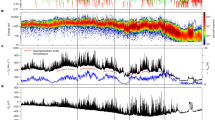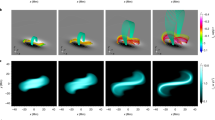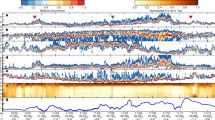Abstract
Heating the outer layers of the magnetically quiet solar atmosphere to more than one million kelvin and accelerating the solar wind requires an energy flux of approximately 100 to 300 watts per square metre1,2,3,4,5,6, but how this energy is transferred and dissipated there is a puzzle and several alternative solutions have been proposed. Braiding and twisting of magnetic field structures, which is caused by the convective flows at the solar surface, was suggested as an efficient mechanism for atmospheric heating7. Convectively driven vortex flows that harbour magnetic fields are observed8,9,10 to be abundant in the photosphere (the visible surface of the Sun). Recently, corresponding swirling motions have been discovered11 in the chromosphere, the atmospheric layer sandwiched between the photosphere and the corona. Here we report the imprints of these chromospheric swirls in the transition region and low corona, and identify them as observational signatures of rapidly rotating magnetic structures. These ubiquitous structures, which resemble super-tornadoes under solar conditions, reach from the convection zone into the upper solar atmosphere and provide an alternative mechanism for channelling energy from the lower into the upper solar atmosphere.
This is a preview of subscription content, access via your institution
Access options
Subscribe to this journal
Receive 51 print issues and online access
$199.00 per year
only $3.90 per issue
Buy this article
- Purchase on Springer Link
- Instant access to full article PDF
Prices may be subject to local taxes which are calculated during checkout



Similar content being viewed by others
References
Parker, E. Dynamical theory of the solar wind. Space Sci. Rev. 4, 666–708 (1965)
Priest, E. et al. Nature of the heating mechanism for the diffuse solar corona. Nature 393, 545–547 (1998)
Schrijver, C. et al. Large-scale coronal heating by the small-scale magnetic field of the Sun. Nature 394, 152–154 (1998)
De Pontieu, B. et al. Chromospheric Alfvénic waves strong enough to power the solar wind. Science 318, 1574–1577 (2007)
Cirtain, J. et al. Evidence for Alfvén waves in solar X-ray jets. Science 318, 1580–1582 (2007)
McIntosh, S. et al. Alfvénic waves with sufficient energy to power the quiet solar corona and fast solar wind. Nature 475, 477–480 (2011)
Parker, E. Nanoflares and the solar X-ray corona. Astrophys. J. 330, 474–479 (1988)
Brandt, P., Scharmer, G., Ferguson, S., Shine, R. & Tarbell, T. Vortex flow in the solar photosphere. Nature 335, 238–240 (1988)
Bonet, J., Márquez, I., Sánchez Almeida, J., Cabello, I. & Domingo, V. Convectively driven vortex flows in the Sun. Astrophys. J. 687, L131–L134 (2008)
Bonet, J. et al. SUNRISE/IMaX observations of convectively driven vortex flows in the Sun. Astrophys. J. 723, L139–L143 (2010)
Wedemeyer-Böhm, S. & Rouppe van der Voort, L. Small-scale swirl events in the quiet Sun chromosphere. Astron. Astrophys. 507, L9–L12 (2009)
Lemen, J. et al. The Atmospheric Imaging Assembly (AIA) on the Solar Dynamics Observatory (SDO). Sol. Phys. 275, 17–40 (2012)
Tu, C.-Y. et al. Solar wind origin in coronal funnels. Science 308, 519–523 (2005)
Nordlund, Å. Solar convection. Sol. Phys. 100, 209–235 (1985)
Bøhling, L., Andersen, A. & Fabre, D. Structure of a steady drain-hole vortex in a viscous fluid. J. Fluid Mech. 656, 177–188 (2010)
Stein, R. & Nordlund, Å. Simulations of solar granulation. I. General properties. Astrophys. J. 499, 914–933 (1998)
Steiner, O. et al. Detection of vortex tubes in solar granulation from observations with SUNRISE. Astrophys. J. 723, L180–L184 (2010)
Shelyag, S., Keys, P., Mathioudakis, M. & Keenan, F. Vorticity in the solar photosphere. Astron. Astrophys. 526, A5 (2011)
Moll, R., Cameron, R. & Schüssler, M. Vortices in simulations of solar surface convection. Astron. Astrophys. 533, A126 (2011)
Kitiashvili, I., Kosovichev, A., Mansour, N. & Wray, A. Excitation of acoustic waves by vortices in the quiet Sun. Astrophys. J. 727 L50. (2011)
Freytag, B. et al. Simulations of stellar convection with CO5BOLD. J. Comput. Phys. 231, 919–959 (2012)
Gudiksen, B. et al. The stellar atmosphere simulation code Bifrost. Code description and validation. Astron. Astrophys. 531, A154 (2011)
Balmaceda, L., Vargas Domínguez, S., Palacios, J., Cabello, I. & Domingo, V. Evidence of small-scale magnetic concentrations dragged by vortex motion of solar photospheric plasma. Astron. Astrophys. 513, L6 (2010)
Attie, R., Innes, D. & Potts, H. Evidence of photospheric vortex flows at supergranular junctions observed by FG/SOT (Hinode). Astron. Astrophys. 493, L13–L16 (2009)
Zhang, J. & Liu, Y. Ubiquitous rotating network magnetic fields and extreme-ultraviolet cyclones in the quiet Sun. Astrophys. J. 741, L7 (2011)
Jess, D. et al. Alfvén waves in the lower solar atmosphere. Science 323, 1582–1585 (2009)
Fedun, V., Shelyag, S., Verth, G., Mathioudakis, M. & Erdélyi, R. MHD waves generated by high-frequency photospheric vortex motions. Ann. Geophys. 29, 1029–1035 (2011)
van Ballegooijen, A., Asgari-Targhi, M., Cranmer, S. & DeLuca, E. Heating of the solar chromosphere and corona by Alfvén wave turbulence. Astrophys. J. 736, 3 (2011)
Cranmer, S., van Ballegooijen, A. & Edgar, R. Self-consistent coronal heating and solar wind acceleration from anisotropic magnetohydrodynamic turbulence. Astrophys. J. 171 (suppl.). 520–551 (2007)
Clyne, J., Mininni, P., Norton, A. & Rast, M. Interactive desktop analysis of high resolution simulations: application to turbulent plume dynamics and current sheet formation. N. J. Phys. 9, 301 (2007)
Acknowledgements
We acknowledge discussions with R. Hammer, M. Carlsson, V. Hansteen and S. McIntosh. M. Carlsson and B. Gudiksen are thanked for providing BIFROST simulation data and input on its analysis. This work was supported by the Research Council of Norway including computing time through the Programme for Supercomputing (Notur). R.E. acknowledges M. Kéray for encouragement and is also grateful to the NSF, Hungary. R.E. and V.F. also acknowledge the support received from the Science and Technology Facilities, UK. The Swedish 1-m Solar Telescope is operated on the island of La Palma by the Institute for Solar Physics of the Royal Swedish Academy of Sciences in the Spanish Observatorio del Roque de los Muchachos of the Instituto de Astrofísica de Canarias. We thank the Computational Information Systems Laboratory at the National Center for Atmospheric Research for providing the VAPOR analysis tool.
Author information
Authors and Affiliations
Contributions
S.W.-B. and E.S. produced and analysed the data with help from all authors. O.S., V.F. and R.E. gave advice on the data analysis, aspects of the physical interpretation and the applied numerical methods. J.d.l.C.R. and L.R.v.d.V. contributed to the collection and preparation of the observational data and its comparison with numerical data. All authors discussed the results and contributed to and commented on the manuscript.
Corresponding author
Ethics declarations
Competing interests
The authors declare no competing financial interests.
Supplementary information
Supplementary Information
This file contains Supplementary Table 1, which outlines the properties of all 14 swirls; Supplementary Figures 1-3, which illustrate the expansion of the magnetic field in a tornado into the solar corona, the comparison of an observed and a simulated swirl, and the related transport of energy; and Supplementary Notes which describe the derivations of the average Poynting flux. (PDF 8301 kb)
Supplementary Movie 1
This movie file shows a brief overview of the SST/CRISP (CRisp Imaging SpectroPolarimeter) data accumulated in this observational study of chromospheric swirls. The detection and properties (Doppler-shift structure and evolution to hotter channels as observed with the SDO) attributed to swirl #1 follows the overview. (MOV 4362 kb)
Supplementary Movie 2
This movie file shows the temporal evolution of all of the 14 swirls detected. Each swirl was recorded during a 55 min observing run on 8th May 2011. (MOV 18241 kb)
Supplementary Movie 3
This movie file outlines the results of a numerical simulation (CO5BOLD) of a solar magnetic tornado. The physical process describing the formation of the magnetic tornado is presented. The evolution of the flow field within the magnetic tornado through to the upper chromosphere is shown, thus, explaining its swirling nature. (MOV 21037 kb)
Rights and permissions
About this article
Cite this article
Wedemeyer-Böhm, S., Scullion, E., Steiner, O. et al. Magnetic tornadoes as energy channels into the solar corona. Nature 486, 505–508 (2012). https://doi.org/10.1038/nature11202
Received:
Accepted:
Published:
Issue Date:
DOI: https://doi.org/10.1038/nature11202
This article is cited by
-
A model of generation of a jet in stratified nonequilibrium plasma
Indian Journal of Physics (2023)
-
On the Physical Nature of the so-Called Prominence Tornadoes
Space Science Reviews (2023)
-
Rapid Rotation of an Erupting Prominence and the Associated Coronal Mass Ejection on 13 May 2013
Solar Physics (2023)
-
Vortex Motions in the Solar Atmosphere
Space Science Reviews (2023)
-
Interaction of convective plasma and small-scale magnetic fields in the lower solar atmosphere
Reviews of Modern Plasma Physics (2022)
Comments
By submitting a comment you agree to abide by our Terms and Community Guidelines. If you find something abusive or that does not comply with our terms or guidelines please flag it as inappropriate.



